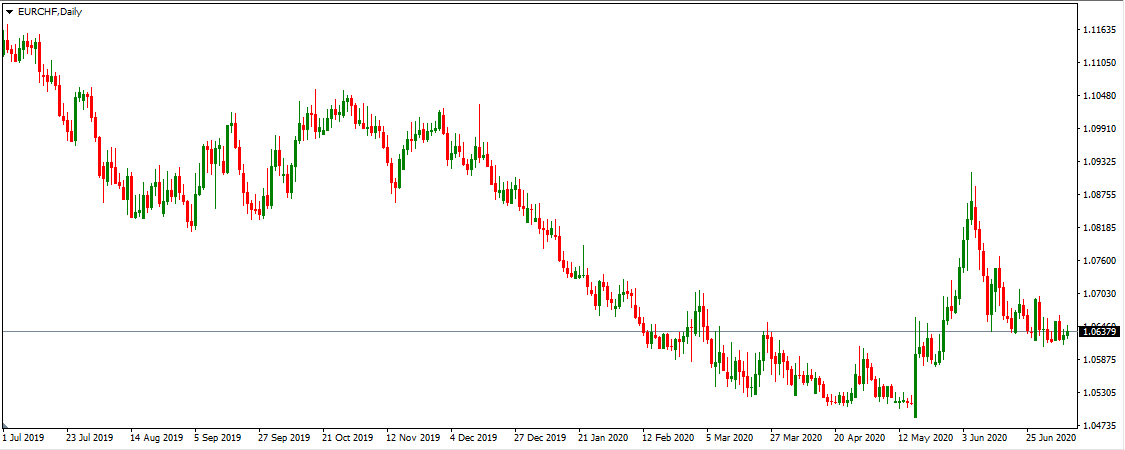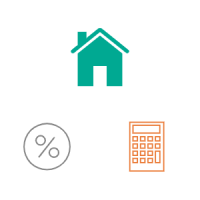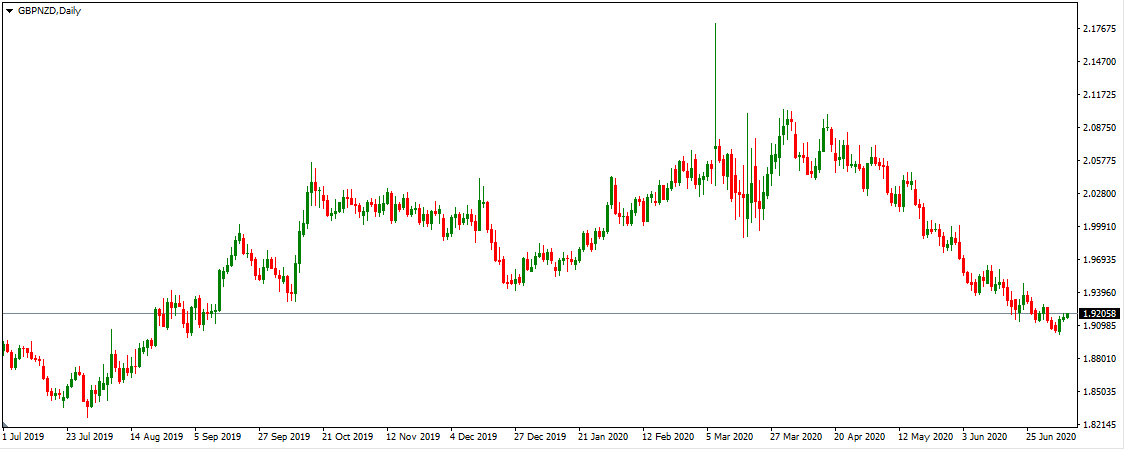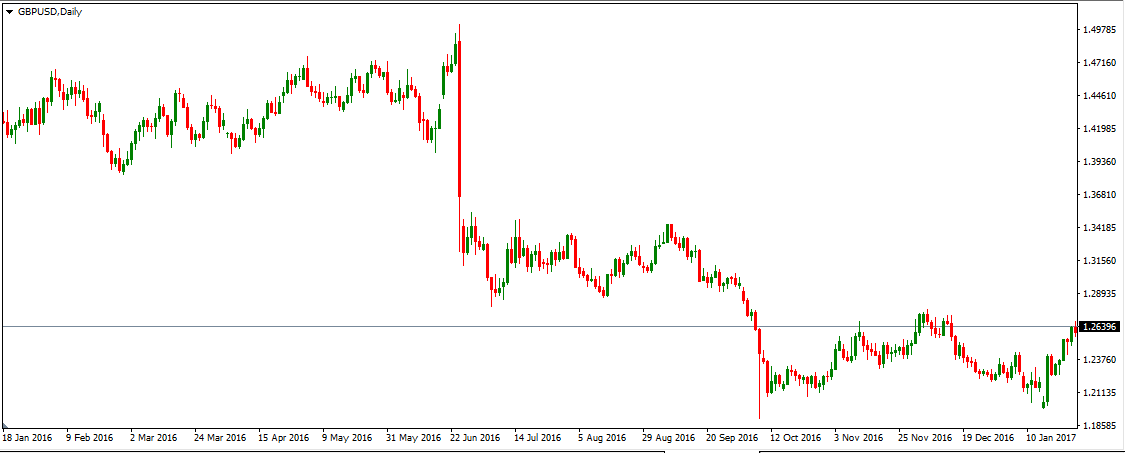Table of content
Many professional Forex traders are emphasizing the importance of having both short term and long term goals. This can certainly help traders with money management, as well as with the successful formulation of Forex strategies.
The first logical step to achieve this would be to analyze the average level of volatility of different currency pairs and set some profit goals with each of those. This can help market participants to have realistic expectations. For example, it will not be reasonable to expect to earn 150 pip profit in a day from the currency pair, which has average daily volatility of 50 pips.
Here it is also worth mentioning that the degree of fluctuations between different currency pairs does not remain unchanged over the years. Instead, some securities might become more or less volatile, depending on the interest rate changes, Gross Domestic Product (GDP), Consumer Price Index (CPI) indicators, and many other economic or even geopolitical factors. Therefore, it might be always a good idea to adjust those short term trading goals in accordance with those changes.
Obviously, experienced traders also often discuss the importance of having long-term Forex trading goals as well. This does mean that defining trading goals on a monthly basis is essential for market participants. When traders know what amount of monthly payouts they are aiming for, they are more likely to take a more disciplined approach and do not overtrade in search of unrealistically high returns.
At the same time, Forex goals do not have to be only represented by the fixed monthly amount. Traders can plan to gradually increase their payouts. This is especially important if an individual treats trading as a full-time job. Just like with any other full-time employment, traders need to try to adjust their income in line with inflation, working hours, and other important factors.
Profit Aims with Low Volatile Currency Pairs
When it comes to even the most liquid currency pairs in the Forex market, there is a considerable amount of difference between the average daily volatility with each of those. On the one side of the spectrum, we have EUR/CHF, which has the average daily fluctuation ranging from 55 to 60 pips. Therefore, this pair is not really famous for major swings. In order to illustrate this better, let us take a look at this daily EUR/CHF daily candlestick chart:

As we can see from the above diagram, 2 years ago the pair was trading close to the 1.11 level. From late July 2019, the Euro began its slide, gradually falling around 1.08 mark before the end of August 2019. At this stage, the pair started to consolidate and mostly moved sideways. In fact, later that year, in November, the single currency even managed to gain some strength and reach a 1.10 level.
This show of strength, however, was very short-lived. From the beginning of December, the Euro began another lengthy downward spiral. However, unlike with many other currency pairs, this move was very gradual and ended in March 2020, as the pair fell just below 1.05 level.
At this point, the tide turned and the single currency even managed to briefly reclaim 1.08 mark during June 2020. However, after this development, the exchange rate faced some correction and EUR/CHF stabilized around 1.06 level by the beginning of July 2020.
So as we can see from this example, the pair has experienced a considerable amount of movement during the last two years. However, the degree of volatility here might not be as high as in the case of other currency pairs. If we take a closer look at the chart, the distance between the high and low points of the exchange rate of the currency pair is roughly 600 to 650 pips. This is not very surprising, because EUR/CHF is indeed one of the least volatile currency pairs.

The reasoning behind this is the fact that EUR/CHF movements are regularly monitored by the Swiss National Bank. This is because approximately 80% of Swiss exports go to Eurozone countries.
Consequently, the sharp appreciation of CHF can deliver a decisive blow to the Swiss economy. If the Swiss franc makes some considerable gains against the Euro, this will make Swiss products much more expensive for Eurozone consumers. Consequently, this can have a notable adverse effect on the trade balance of the country. Since the net export category is one of the components of the Gross Domestic Product, a worsening trade balance also can considerably slow down the rate of the economic growth of Switzerland.
In order to address those concerns, the Swiss National Bank even introduced a 1.20 floor for EUR/CHF in 2011 and managed to enforce it until January 2015. This policy was abandoned, because of the quantitative easing program of the European Central Bank. However, this clearly can not stop SNB from intervening if EUR/CHF falls sharply.
On the other side of the equation, there is very little potential for Euro appreciation. The European Central Bank holds its key refinancing rate at 0%, with the deposit facility at -0.5%. Therefore, the Euro at current rates is not very attractive for investors, savers, and carry traders. Faced with fundamental weakness from both sides of the coin, the EUR/CHF moves very gradually and large movements in this pair are indeed very rare.
This means that when traders decide to open positions with EUR/CHF, the realistic approach to this would be to set a daily profit goal of 25 to 30 pips. Expecting a 100 to 150 pip profit from this pair on a daily basis would be very unrealistic and can usually lead to disappointment.
How to Set Forex Goals with Specific Currency Pairs?
Obviously, EUR/CHF is not the only currency pair with distinct low volatility. Other such pairs include USD/CHF, NZD/USD, AUD/USD, EUR/GBP, USD/CAD, AUD/NZD, and some others.
Trading those types of currency pairs might be a worthy choice for those traders, who want to minimize their risk exposure and settle for relatively smaller payouts, rather than taking very serious risks.
So the main principle with Forex trading goals is to identify the average degree of daily volatility of a given currency pair and set those aims which can be the equivalent of roughly half of those figures. The reasoning behind this is the fact that if a given currency pair has an average daily volatility of 60 pips, it does not mean that this will always be the case. Sometimes, the pair might fluctuate much less than usual. Therefore in order to stay on the safe side of the trade, setting the profit goal of 30 pips might be a more prudent thing to do.
For long term traders, it might be a better idea to calculate the difference between the 1-year lows and highs and set the goal at the number which will be 50% of that. In our previous example, this figure with EUR/CHF was near 600 pips, therefore, setting the long term trading aim at the profit of 300 pips can be a reasonable solution.
This information is widely available at Forex news and brokerage websites. In fact, in some places, traders can even find some calculators, which can help them to calculate the average daily volatility figures for major and minor currency pairs for a specific period of time.
Forex Goal Setting with Highly Volatile Currencies
Obviously, not all currency pairs are known for this type of low volatility, we described above. On the opposite spectrum, we have currency pairs like GBP/NZD, the average daily volatility of which ranges from 200 to 205 pips.
To illustrate the movement of this currency pair for the last 12 months, let us take a look at this daily GBP/NZD candlestick chart:

As we can see from the diagram above, a year ago, the pair was trading close to $1.89 level. After the initial decline during the first two months of summer 2019, the pound has fallen to $1.84 mark. However, this weakness turned out to be short-lived. In the course of the subsequent months, the British currency has made some steady gains, until reaching its peak in April 2020, at $2.10. After this show of strength, the pound began its slide and by early July 2020, the GBP/NZD pair was already down to $1.92.
So in this, the differential between the 12-month low and high is approximately 2,600 pips. This is in sharp contrast to our previous example, where this number with EUR/CHF was just at 600 pips.
Here it is worth keeping in mind that comparing average daily or yearly fluctuations between those two currency pairs might not be exactly an apple to apple comparison. It will suffice to say that in percentage terms 600 pip movement with EUR/CHF is more significant than 600 pip change with GBP/NZD. However, the difference between those two is so large that even on percentage terms GBP/NZD turns out to be more volatile than EUR/CHF.
Obviously, market participants are always free to set their Forex trader goals according to specific percentages. However, it is also worth noting that for many traders it might be much simpler to define aims in terms of the number of pips. Since with this method, it is much easier to apply this standard with dozens of currency pairs.
The reasoning behind the higher degree of volatility with GBP/NZD can be several. Firstly, until March 2020, both the Australian dollar and New Zealand dollar were considered high yielding currencies. The fact of the matter is that as the majority of the world’s major central banks dropped their interest rates near zero, in the aftermath of the 2008 great recession, this was not the case with the Reserve Bank of New Zealand.
The policymakers in the country kept rates at 2.5%. During the subsequent years, the official cash rate in New Zealand fluctuated between 1% to 3.5%, depending on the inflation rate and other economic indicators. Those frequent changes in the monetary policy obviously led to greater volatility for some NZD-based currency pairs including GBP/NZD.
On the other side of the equation, the pound became much more volatile after the United Kingdom EU referendum. This brought a great deal of uncertainty, which further increased the volatility of GBP/NZD.
So at this stage, the clear question is: how can a trader set realistic Forex goals with GBP/NZD pair? Well, since we are now well-aware of the fact that the average daily variation of pairs is 200 pips and the distance between 12-month highs and lows is 2,600 pips, the process is simple. In this case, traders can set a daily profit goal of 100 pips for short term trades. For long term trades, market participants can choose a target of up to 1,300 pips.
Finally, it is important to note that setting realistic short term goals is an important factor for a successful trading career. However, this does not necessarily mean that it can always guarantee long term success. Traders still need to conduct a detailed technical and fundamental analysis in order to maximize their chances of earning regular payouts.
Changes in Average Volatility
Now, one this to keep in mind here is that the average degree of volatility of specific currency pairs may not stay the same over the years. As a result of some economic or even political factors, some securities might become more or less volatile than before.
To illustrate one example of such a scenario, let us take a look at this daily GBP/USD chart:

As we can see from the above image, at the beginning of 2016 the pair was trading near $1.43 level. After some months of fluctuations, the pound did briefly fall to the $1.38 mark, but later has made some steady gains and even reached the $1.50 level by June 2020. So at this point in time, the distance between the low and high levels was approximately 1,200 pips.
However, the result of the EU referendum has increased the volatility of the pair dramatically. In fact, during the very first day, after the announcement of results, the pound fell from $1.50 to below $1.37. This means that in one day the pair experienced greater volatility, than the first 6 months of the year combined.
However, this was not really just a one-off event. The pound did stabilize around the $1.29 to $1.35 range for a few months. However, from October 2016 the British currency resumed its downward trend, eventually reaching a multi-decade low of $1.20 in January 2017 and recovering to $1.27 by the end of the month.
So as we can see from this example, after the EU referendum, the distance between the highs and lows of the GBP/USD pair has expanded from 1,200 pips to 3,000 pips. The reasons for these major shifts were several.
Firstly, the departure of the United Kingdom from the European Union created a great deal of uncertainty about the trade relationship between them. There was always a fear in the market that in the event of no-deal Brexit, the UK economy will be hit with tariffs and other trade restrictions. This can certainly make the trade balance picture of the country much worse and consequently slow down the rate of economic growth.
The second important implication of the EU referendum result was the opening of discussions about the possibility of the second Scottish independence referendum. The fact of the matter is that Scotland voted to stay in the EU by 62%. However, because the UK as a whole voted to leave, this forced Scotland to leave the European Union as well.
Consequently, the first minister of the nation, Nicola Sturgeon has already announced her intention to fight for the second Scottish independence referendum. So far, the central government in London has already rejected those calls. However, this statemate might not persist forever.
So Brexit brought the threats of tariffs on UK exports, as well as the prospect of the breakup of the Union, which in turn put tremendous pressure on the pound and made GBP/USD much more volatile.
As we can see from this example, sometimes traders might have to adjust their trading goals, in order to account for the changing circumstances of different currency pairs.
Profit Goals Forex Trades Can Set for Long Term
When it comes to setting realistic goals for Forex trading, it does not only apply to trade individual currency pairs. Obviously, the main aim of trading is to earn some income from the effort. Therefore, setting a monthly goal for this purpose can be very helpful in two ways.
Firstly, it can protect market participants to avoid having unrealistic expectations. Without any defined aim, traders might overtrade and lose a considerable amount of money in the process. On the other hand, having the specified aim, market participants know where to limit further trading and avoid taking unnecessary risks.

Second, having a pre-define aim introduces a degree of predictability to one’s life. In this case, he knows that for those efforts, he or she can receive a specific amount of money. This can be very important for maintaining the motivation, even in times of some setbacks.
Now, obviously setting a specific goal does not necessarily guarantee that a trader will always receive this specific amount. It goes without saying that traders must make sure that those aims are realistic.
One way to achieve this to use a demo account as a measuring rod. For example, if a trader earns a $1,000 profit during the month on this type of account, then setting a monthly goal of $3,000 might not be a good idea. Instead, it should be the equivalent of the previous result or slightly below this level.
Alternatively, traders can also make use of Forex simulation software. The difference between those and demo accounts is that the former allows market participants to use time travel options. As a result, market participants can open positions in the past and then fast forward several days or weeks later, to check the outcome of their trades.
So here traders can accumulate 12 months of trading results in rather a short period of time. Then what they can do is calculate the monthly average and use it to set a profit goal for real trading.
Here it is worth noting that once the trader determines the monthly goal he or she is comfortable with, this does not mean that this amount has to remain unchanged for years. It might be a better idea to increase the amount gradually over time. The reasoning behind this is the fact that nearly every major currency has an average inflation rate, ranging from 2% to 3%. This means that traders need to increase their revenues over time, in order for their income to maintain purchasing power.
Another possible reason for adjusting the aim upwards might be the fact that the trader might decide to invest more hours into trading. Obviously in this case he or she might want to aim for higher goals, to get a proper reward for those extra efforts. Finally, as traders gain more experience over the years, they might improve their profitability and adjust their aims upwards, in order to account for those developments.
Setting Goals for Forex Trading – Key Takeaways
- Forex trading manuals and guides often discuss the importance of having both short and long term goals. In order to achieve this, traders can analyze the average daily volatility of different currency pairs and set their profit goals accordingly. Some currency pairs are much more volatile than others because of different economic and political reasons. In general, it might be a productive move to set daily profit goals lower than the average daily volatility of the given currency pair. This can certainly help traders to reduce risks and potentially improve the ratio of winning trades.
- Traders should keep in mind that the degree of volatility between different currencies does not always remain unchanged over the years. Instead, we have plenty of examples where some currency pairs became more or less volatile, due to the changes in the interest rates, major geopolitical events, or many other factors. Consequently, it can be a prudent move to adjust profit goals with individual currency pairs in order to account for those types of changes.
- Having long term Forex trading goals can also be potentially very helpful for market participants. To achieve this, traders can utilize demo and Forex simulator accounts. This allows them to measure their performance over the weeks and months. After this stage, traders can choose monthly profit goals in line with those results. Finally, from time to time market participants can incrementally raise the amount, in order to account for inflation, changing working hours, experience, and other factors.



